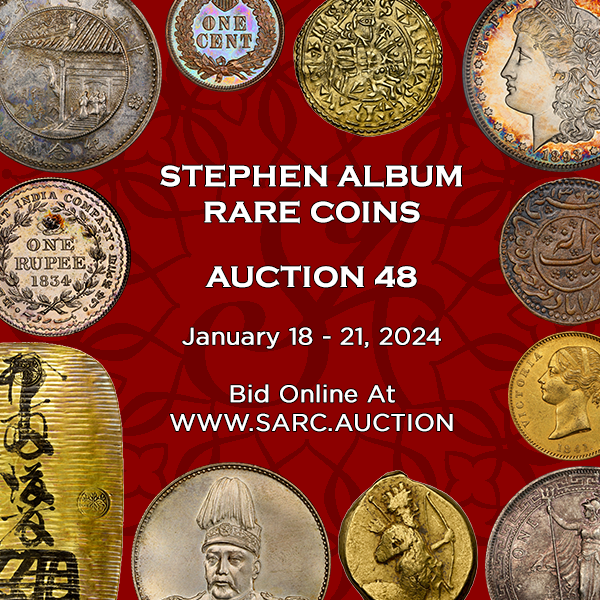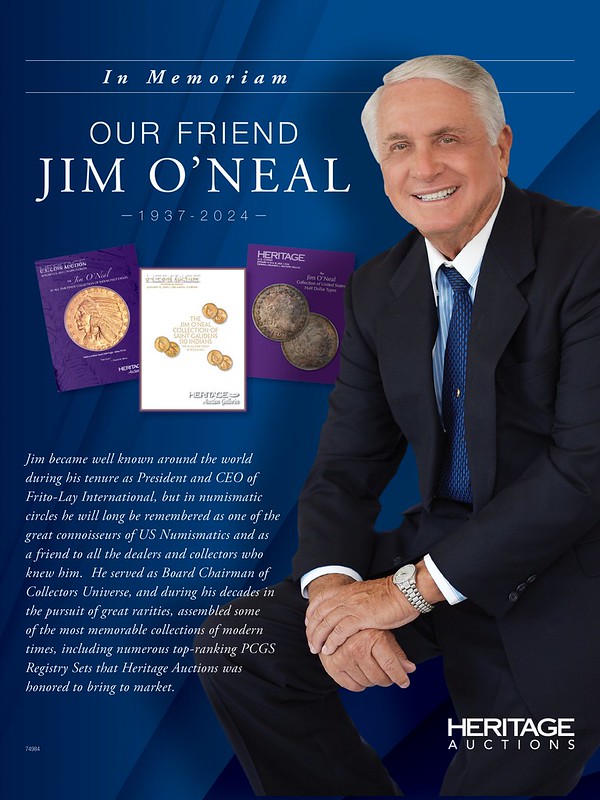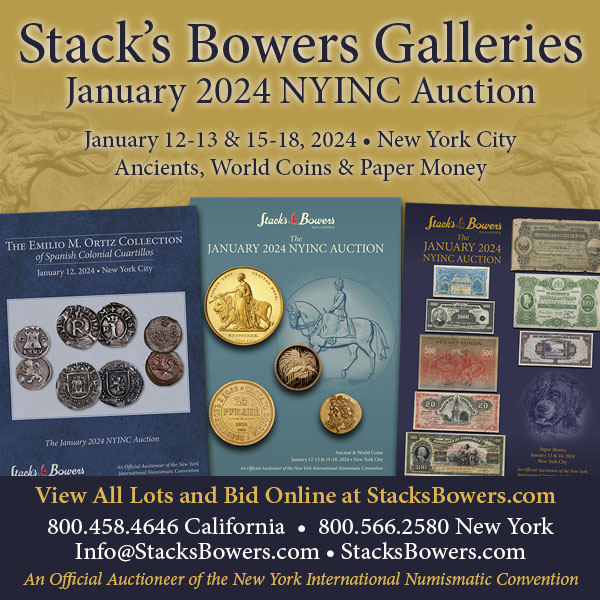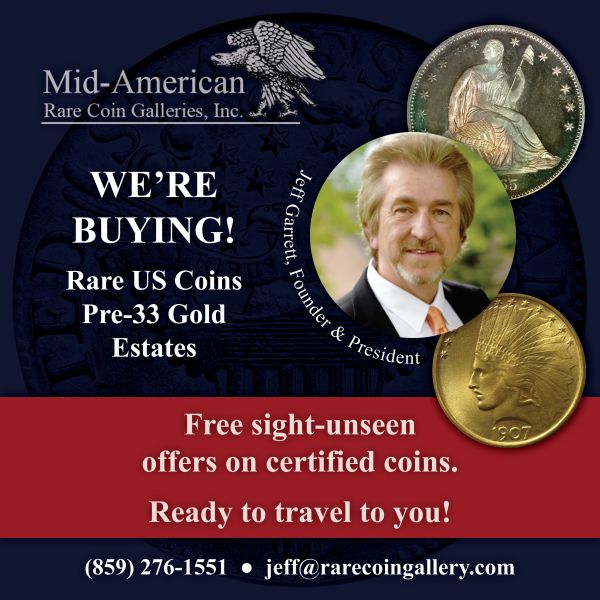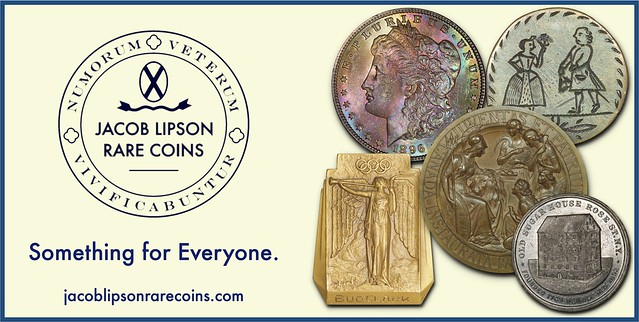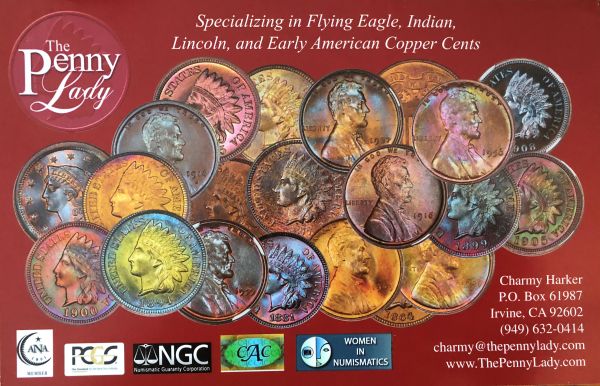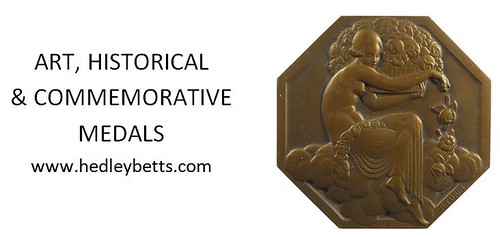
Visit our NBS Sponsors




About UsThe Numismatic Bibliomania Society is a non-profit association devoted to the study and enjoyment of numismatic literature. For more information please see our web site at coinbooks.org SubscriptionsThose wishing to become new E-Sylum subscribers (or wishing to Unsubscribe) can go to the following web page link MembershipThere is a membership application available on the web site Membership Application To join, print the application and return it with your check to the address printed on the application. Print/Digital membership is $40 to addresses in the U.S., and $60 elsewhere. A digital-only membership is available for $25. For those without web access, write to: Jeff Dickerson, Treasurer AsylumFor Asylum mailing address changes and other membership questions, contact Jeff at this email address: treasurer@coinbooks.org SubmissionsTo submit items for publication in The E-Sylum, write to the Editor at this address: whomren@gmail.com BUY THE BOOK BEFORE THE COIN |
- WAYNE'S WORDS: THE E-SYLUM JANUARY 14, 2024
- NEW BOOK: GERMAN BANKNOTES, 23RD ED.
- RCNA LIBRARY ARRIVES AT NICKLE GALLERIES
- HON. JAMES PATRICK FLANNERY, JR. (1950–2023)
- HOWLAND WOOD CORRESPONDENCE SCANNED
- VIDEO: CHECK COLLECTING
- DUTCH DEFEAT OF THE SPANISH ARMADA MEDAL
- MORE ON DUBLIN JEWELLER EDMUND JOHNSON
- NOTES FROM E-SYLUM READERS: JANUARY 14, 2024
- JUSTIN'S MULTI-STATE COIN SHOP TRIP
- RECOGNIZING COINS WITH ARTIFICIAL INTELLIGENCE
- VOCABULARY TERM: PANTOGRAPH, PART ONE
- SPCA AND HUMANE SOCIETY SEALS AND MEDALS
- TOM CALDWELL INTERVIEW, PART THREE
- PRINCETON COLLECTION ADDS AKSUMITE COINS
- NUMISMAGRAM MEDAL SELECTIONS: JANUARY 14, 2024
- TANKERSLEY WEST INDIAN COINS AND TOKENS
- INTERESTING NOTES IN WBNA SALE #54
- NUMISMATIC NUGGETS: JANUARY 14, 2024
- GREEK COINS FOUND AT HADRIAN’S AQUEDUCT
- THE COINS OF JUSTINIAN II
- THE JANUARY 1816 U.S. MINT FIRE
- THE 1893 AUSTRALIA SYDNEY PROOF SOVEREIGN
- MEDALLIC ART EXHIBIT: PROGRESSION
- CRAFTY COUNTERFEIT DISPLAY, PART TWO
- 1770 WEST VIRGINIA LOG FORT UNCOVERED
- LOOSE CHANGE: JANUARY 14, 2024
- TOKYO COIN-DISPENSING VENDING MACHINE
Content presented in The E-Sylum is not necessarily researched or independently fact-checked, and views expressed do not necessarily represent those of the Numismatic Bibliomania Society.
WAYNE'S WORDS: THE E-SYLUM JANUARY 14, 2024
 New subscribers this week include:
Merfyn Williams, courtesy Jeff Rock,
Denis Richard,
John Russell, and
Mary Yacovone.
Welcome aboard! We now have 7,643 subscribers.
New subscribers this week include:
Merfyn Williams, courtesy Jeff Rock,
Denis Richard,
John Russell, and
Mary Yacovone.
Welcome aboard! We now have 7,643 subscribers.
Thank you for reading The E-Sylum. If you enjoy it, please send me the email addresses of friends you think may enjoy it as well and I'll send them a subscription. Contact me at whomren@gmail.com anytime regarding your subscription, or questions, comments or suggestions about our content.
This week we open with one new book, a numismatic library move, updates from the Newman Numismatic Portal, notes from readers, and more.
Other topics this week include Howland Wood, check collecting, visiting coin shops, pantographs, fixed price and auction previews, coin finds, the 1816 Mint fire, and a coin vending machine.
To learn more about German banknotes, Nickle Galleries, numismatic dealer directories, RCNA convention programs, recognizing coins with artificial intelligence, coins of the Aksumite empire, the Edinburgh Mint, the coins of Justinian II, the 1893 Australia Sydney Proof Sovereign, and vacuum-packed bundles of cash, read on. Have a great week, everyone!
Wayne Homren
Editor, The E-Sylum
NEW BOOK: GERMAN BANKNOTES, 23RD ED.
A new edition of the Grabowski catalog of German banknotes has been published. Here's a Google-translated description from the publisher's website. -Editor
 The German banknotes from 1871
The German banknotes from 1871
Hans Ludwig Grabowski
The paper money of the German central banks, government paper money, colonial and occupation issues, German tributaries and banknote-like securities and vouchers
Title: Battenberg Verlag
ISBN: 978-3-86646-224-3
Edition: 23rd edition 2023/2024
Dimensions: 14.8 x 21 cm
Type of figures: colored throughout
Type of cover: Hardcover
Number of pages: 864
THE BOOK BAZARRE
RCNA LIBRARY ARRIVES AT NICKLE GALLERIES
Last March it was announced that the Royal Canadian Numismatic Association's library would move to Nickle Galleries in Calgary. The move is now complete. Here's a report from Canadian Coin News. -Editor
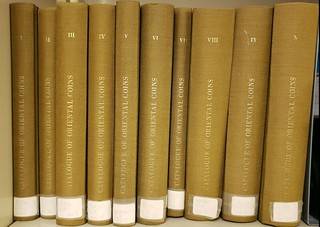 For decades, University of Calgary’s Nickle Galleries has had the largest and most important academic coin collection in Canada, the Nickle Numismatic Collection. This rich teaching and research resource comprises over 16,000 ancient Greek and Roman coins, 7,000 medieval coins as well as early modern coins, bank notes and non-Western currencies. It also includes significant holdings of related artifacts dating from the 7th century BCE.
For decades, University of Calgary’s Nickle Galleries has had the largest and most important academic coin collection in Canada, the Nickle Numismatic Collection. This rich teaching and research resource comprises over 16,000 ancient Greek and Roman coins, 7,000 medieval coins as well as early modern coins, bank notes and non-Western currencies. It also includes significant holdings of related artifacts dating from the 7th century BCE.
Now, Nickle Galleries is also home to an extensive library curated by the Royal Canadian Numismatic Association (RCNA) and consisting of more than 5,000 items. The collection includes reference and rare books, manuscripts, periodicals, and ephemera relating to coins, medals, tokens, and bank notes. It covers ancient and modern historic periods, countries and continents, in a number of different languages.
HON. JAMES PATRICK FLANNERY, JR. (1950–2023)
Len Augsburger passed along word of the passing of Chicago Coin Club member Jim Flannery. Sorry to hear the news. -Editor
 Hon. James Patrick Flannery, Jr. (1950 – 2023) of Chicago, Illinois passed on October 13, 2023, he was 73 years of age. Jim became member number 1056 when he joined the Chicago Coin Club in April of 1996.
Hon. James Patrick Flannery, Jr. (1950 – 2023) of Chicago, Illinois passed on October 13, 2023, he was 73 years of age. Jim became member number 1056 when he joined the Chicago Coin Club in April of 1996.
From his early high school days at LaLumiere high school in LaPorte Indiana, Jim was a well-respected student and athlete. Jim was a member of the 1968 charter class at Lalumiere.
Jim earned his B.S. in mathematics from Illinois Institute of Technology in 1973 and completed his J.D. at the University of Illinois at Chicago John Marshall Law School in 1976
Jim was admitted to the bar in 1976 and has been a judge since 1988, he was transferred to the Law Division in 1997. In 2014 he was appointed presiding judge of the Law and was last retained in the November 2020 General Election.
HOWLAND WOOD CORRESPONDENCE SCANNED
The latest addition to the Newman Numismatic Portal is correspondence of ANS Curator Howland Wood. Project Coordinator Len Augsburger provided the following report. -Editor
Howland Wood Correspondence Scanned
Howland Wood (b. 1877) served as the American Numismatic Society (ANS) Curator from 1913 until his passing in 1938. The Society has preserved his extensive correspondence files, which are currently being digitized by Newman Portal at the ANS library. Already over 400 separate correspondents, covering the letters A-B, are represented in this group. While many of the correspondent names are obscure, the “usual suspects” are well represented, with David Bullowa, F. C. C. Boyd, M. H. Bolender, and Bauman Belden found in the first few pages of search results.
VIDEO: CHECK COLLECTING
The David Lisot Video Library on the Newman Numismatic Portal can be found at:
https://nnp.wustl.edu/library/multimediadetail/522852
We highlight one of his videos each week in The E-Sylum. Here's one from 1985 where David interviews his father Larry about check collecting. -Editor
DUTCH DEFEAT OF THE SPANISH ARMADA MEDAL
Regarding the reproduction Dutch medal "paperweight", Stuart Weinerman writes:
Here is a description from a CNG sale:
TUDOR. temp. Elizabeth I. 1558-1603. AR Medal (51mm, 40.70 g, 12h). Defeat of the Spanish Armada. By G. van Bijlaer. Dated 1588. + FLAVIT × × ET × DISSIPATI × SVNT × 1588 ( God blew, and they (the Spanish fleet) were scattered ), large fleet of ships under sail right, being dispersed; above, name of God in Hebrew within rayed clouds / (castle) × ALLIDOR × NON × LÆDOR × ( I may be assailed, but not injured ), church set upon rocky island, being buffeted by heavy winds and waves; below, crowned coat-of-arms of Maurice. MI 145/112; Eimer 57; van Loon I, p. 392. VF, toned, removed from mount. Very rare. Ex Classical Numismatic Review XX.2 (Summer 1995), no. 945. As the destruction of the Spanish Armada consisted largely of a violent storm upon the seas, divine intervention is duly acknowledged upon the obverse of this medal. Since the armada was drawn chiefly against Elizabeth, the principal head of the Anglican Church, its cause was viewed as an attack upon the Church itself and is clearly represented on the reverse.
MORE ON DUBLIN JEWELLER EDMUND JOHNSON
Peter Preston-Morley of Noonan's writes:
"I can add a little to your piece on ‘Very Puzzling Coins from Dublin’. These tiny silver medalets by the Dublin jeweller Edmund Johnson do occasionally appear on the UK market – a specimen is included in the portion of the collection of the late Barry Woodside, to be sold by Noonans in February. Johnson described himself as ‘Jeweller to the Irish Court’ and his premises were at 94-95 Grafton Street, Dublin, and also at 46 Wicklow Street. He held a royal warrant under Edward VII, though Edmund had been active since at least 1863, when he took over the family business from his father, also Edmund; he won a bronze medal at the Dublin Exhibition of Arts, Industries and Manufactures, 1872. The Johnson business closed down in 1925."
So far the mysteries of Johnson's puzzles are intact - none of our readers has even hazarded a guess. Wondering if the answer may be in unscrambling the letters into a sentence, I tried some online unscramblers and Words In A Sentence generators and came up empty. Some of the words found within ASRWSROIOEHWUOMNEMPH include "horsemanship", "washerwomen" "whorehouses", "harmonious", "horsepower", "shipowners", "whisperers", "womanizers", "worshipers", "merriness", "shipowner", "earworms", "rosaries", "mourner", "poisons", "wieners", "heroes", "opium", "earns", "soars", "hens", "iron", and "snow". You might think a generative AI Large Language Model would make short work of this, so I asked Microsoft's Bing CoPilot to write me a sentence using only the letters "AETENVMTEFISIRISTSEALI" and got this:
“I’ve seen a sea of fireflies in the mist, it’s a sight to marvel at!”
Um, quite poetic, but wrong - that's way more letters than we started with. So next I asked, write me a sentence using each of these letters "AETENVMTEFISIRISTSEALI" only once.:
Here’s a sentence using each of the letters “AETENVMTEFISIRISTSEALI” only once: “A fine sieve strains tea leaves.” This sentence is called a pangram because it contains every letter of the alphabet at least once. Pangrams are also referred to as holoalphabetic sentences or alphabet sentences. There are many other pangrams that exist, some of which are more challenging to construct than others. For example, “The quick brown fox jumps over the lazy dog” is one of the most widely known pangrams 1.
Better, but still not there - the letter count doesn't match (and all 26 letters of the alphabet aren't in the string). Maybe this is a dead end, but perhaps gives someone an idea for further experimentation. Maybe we're on track after all. -Editor
Gawain O'Connor writes:
"I believe if any can solve the mystery of these pieces, they would be among your subscribers. I forgot to mention that the Columbian Exposition piece is listed in Eglit, E-215 [Columbiana: The Medallic History of Christopher Columbus and the Columbian Exposition of 1893 by Eglit, Nathan N - 1965]"
To read the earlier E-Sylum article, see:
UNSOLVED NUMISMATIC PUZZLES FROM DUBLIN
(https://www.coinbooks.org/v27/esylum_v27n01a09.html)
NOTES FROM E-SYLUM READERS: JANUARY 14, 2024
Directory of Numismatic Dealers
Terry Freed of the DesMoines, Iowa coin club writes:
"Regarding Pete Smith's "Numismatic Rogues Gallery" article in The E-Sylum 31 Dec 2023 - although this may seem excessive and burdensome to maintain, how come you never see a list of numismatic dealers that have their inventory on the internet? At this point in time it seems like luck to come across ones that do. I have no idea where it would be posted to do the most good for collectors. I do know from experience that Northeast Numismatics must have a genius that designed their website, it is so easy to maneuver. Just an idea that may never come to pass."
 Directories of numismatic dealers are perennially useful, and have appeared regularly in print since the earliest days of collecting. In the early days of the internet (spelled with a capital "I" back then), there were various commercial and crowdsourced directories online. Then improved web searching came along and made them largely obsolete. I say "largely" because searching only works when you know what you're looking for. I don't have to remember the web address for Northeast Numismatics because I can always find it with a search engine, even if the address has changed.
Directories of numismatic dealers are perennially useful, and have appeared regularly in print since the earliest days of collecting. In the early days of the internet (spelled with a capital "I" back then), there were various commercial and crowdsourced directories online. Then improved web searching came along and made them largely obsolete. I say "largely" because searching only works when you know what you're looking for. I don't have to remember the web address for Northeast Numismatics because I can always find it with a search engine, even if the address has changed.
But lists are quite useful for discovering what you DON'T already know about a topic - published lists of dealers enable browsing. For bibliophiles it's the equivalent of being able to walk through the shelves in a library or bookstore, enabling the discovery of books you didn't know you wanted.
As Terry notes, the labor involved in manually creating and maintaining such lists is a problem, which commercial publications solve by charging dealers to advertise, and maintaining a list of said advertisers. This would of course never be an all-encompassing list of all dealers, but the larger publications can support very useful directories of the major and midsize dealers. -Editor
To read the earlier E-Sylum articles, see:
ROBERT WOOD MERCER (1840-1894)
(https://www.coinbooks.org/esylum_v18n49a18.html)
NNP ADDS SMITH'S NUMISMATIC ROGUES GALLERY
(https://www.coinbooks.org/v26/esylum_v26n53a05.html)
Other topics this week include the Vermont Pound theory, RCNA convention programs, and Presidential Engravings. -Editor
JUSTIN'S MULTI-STATE COIN SHOP TRIP
Justin Hinh submitted this report on his recent coin shop scouting trip. Thanks! -Editor
I thought you and your readers would enjoy this story about the trip I took last month where I dropped by 23 coin shops across four states looking for rare Dansco albums and other coin-collecting supplies.
Four states, 1,500 miles, 23 coin shops, a disastrous hotel stay, and 10 days later...
RECOGNIZING COINS WITH ARTIFICIAL INTELLIGENCE
Tom Babinszki publishes the Blind Coin Collector blog. With permission, we're republishing his recent article on recognizing coins with artificial intelligence. Thanks! -Editor
 Over the last year, many new opportunities became available for me to learn about coins with the use of artificial intelligence. These developments truly open a new chapter in what coin collecting could mean to me without vision.
Over the last year, many new opportunities became available for me to learn about coins with the use of artificial intelligence. These developments truly open a new chapter in what coin collecting could mean to me without vision.
Previously I wrote a lot about recognizing coins with technology, so far what is still working and available is Seeing AI by Microsoft. What I was able to do is using optical character recognition to get enough text from a coin to tell what it is. It mostly works with good quality coins and good quality pictures. After I determine what a coin is, I use Numista to get more information, however, what I am able to get really depends on the descriptions users provide.
These days, there are several options to use AI to describe images. The other advantage here is that unlike with regular character recognition, AI understands when the text goes around the coin, and instead of looking for straight lines of characters, it is able to process the characters in a circular direction. Thus, the accuracy greatly improves.
VOCABULARY TERM: PANTOGRAPH, PART ONE
Here's the first of two parts of the lengthy Pantograph entry from Dick Johnson's Encyclopedia of Coin and Medal Terminology. -Editor
Pantograph, Die-engraving Pantograph. A machine for reducing three-dimensional bas-relief designs while simultaneously cutting a steel die. The mechanical engraving machine, which was early called a portrait lathe and later called a reducing machine among other names, eliminates the requirement of manual labor to meticulously cut dies by hand engraving. It had the further advantages that many dies could be cut from one pattern, more than one size die could be reduced from the same pattern, the pattern could be seen complete before being placed into production of diecutting, and the ease of which design errors could be corrected.
The use of the pantograph in early mints – like the use of the collar, certain other blanking and striking techniques – was part of the mystique of coin making. As such, it was part of the technology closely guarded by mint personnel. To safeguard against coin counterfeiting early on the knowledge of the pantograph was not revealed to a general public (in England or America, but was published as coining technology in France and Germany).
SPCA AND HUMANE SOCIETY SEALS AND MEDALS
E-Sylum Feature Writer and American Numismatic Biographies author Pete Smith submitted this article inspired by Dave Baldwin's South Carolina SPCA medal. Thanks! -Editor
The first Society for the Prevention of Cruelty to Animals (SPCA) was established in England in 1824. The movement has spread to independent branches around the world. The American Society for the Prevention of Cruelty to Animals (ASPCA) was established in 1866.
The seal of The American Society for Cruelty to Animals was drawn by Frank Leslie and first published in 1867. The Central design was reproduced for other seals and medals.
TOM CALDWELL INTERVIEW, PART THREE
Greg Bennick's latest interview for the Newman Numismatic Portal is with Tom Caldwell of Northeast Numismatics. Here's the third of four parts, where Tom discusses coin shows and auctions. -Editor
GREG BENNICK: Yeah, we definitely will. So, I mentioned coin shows earlier. How have coin shows changed over the years? I just imagine that going to a show, say in the late 1960s, early 1970s, would be a different experience than today. I would love to talk a little bit or hear a little bit about how coin shows have changed.
 TOM CALDWELL: Well, they definitely have changed. I want to say they were
more prominent, more important for the dealings back in the past, not so much
anymore, but we find that, we go to a show now and we tell somebody walking by
that we have a lot of coins not on display, and ask “Anything you're looking for?”’,
and they'll say, “Well, they've already seen your coins” because they've already
seen them on our website. But the shows are still important today just for folks to
get out and see people, see the competition, and just to get a better view of just
what's out there. But I say that the shows, there will always be shows, but with
online business being in many ways more prominent, the shows will not be as
important.
TOM CALDWELL: Well, they definitely have changed. I want to say they were
more prominent, more important for the dealings back in the past, not so much
anymore, but we find that, we go to a show now and we tell somebody walking by
that we have a lot of coins not on display, and ask “Anything you're looking for?”’,
and they'll say, “Well, they've already seen your coins” because they've already
seen them on our website. But the shows are still important today just for folks to
get out and see people, see the competition, and just to get a better view of just
what's out there. But I say that the shows, there will always be shows, but with
online business being in many ways more prominent, the shows will not be as
important.
GREG BENNICK: What about auctions? I know that you've gone to auctions going back, at this point, 50 years. How have the auctions changed? And do you have any memorable auction moments that you love from back in the day?
TOM CALDWELL: Well, they've definitely changed. I mean, again, just the very recent past is through COVID, the auctions are now — like we just came back from the Baltimore show. And they were showing lots there, but there was no auction at the show. The auctions are after the show now. They found that to work just as well. Because certainly the coin auctions didn't change during COVID. There were still just as many auctions. Auction companies found they don't necessarily have to sell the coins at the shows. It's actually made for maybe a little more civilized coin show that we're not have to rush to the auction room to bid and be up till 1:30 in the morning at a session. And so that's the way it's worked out over time in that regard. But I'd say that shows will always be there, but just not as important as in the past.
PRINCETON COLLECTION ADDS AKSUMITE COINS
Alan Stahl’s student Jenica Brown's interest in medieval and early modern Ethiopian coinage led to the growth of Princeton’s numismatic collection. -Editor
 Jenica Brown, A&A graduate student interested in medieval and early modern Ethiopia, has played an unexpected role in growing Princeton’s numismatic collection. Currently a student in Curator of Numismatics Alan Stahl’s course CLA 548/HLS 548/PAW 548/ART 532 “Problems in Ancient History: Introduction to Ancient and Medieval Numismatics,” Brown was particularly interested in coins of the Aksumite empire, which existed from the first to early seventh centuries in present-day Ethiopia and Eritrea.
Jenica Brown, A&A graduate student interested in medieval and early modern Ethiopia, has played an unexpected role in growing Princeton’s numismatic collection. Currently a student in Curator of Numismatics Alan Stahl’s course CLA 548/HLS 548/PAW 548/ART 532 “Problems in Ancient History: Introduction to Ancient and Medieval Numismatics,” Brown was particularly interested in coins of the Aksumite empire, which existed from the first to early seventh centuries in present-day Ethiopia and Eritrea.
When the class began, Princeton’s numismatic collection housed four Aksumite coins, acquired by Stahl in spring 2023. Aware of Brown’s interest, Stahl not only leapt at the opportunity to grow the Aksumite coin collection when he saw the currency come up for auction, but involved Brown in the selection process. Stahl noted, “Some years back graduate student Meseret Oldjira asked about working on Axumite coins for her project for this seminar, but as we had none she worked on coins of ancient Saba (Biblical Sheba). When I saw the Axumite coins for sale at a dealer’s table at the Kalamazoo Medieval Congress last year, I took the opportunity to begin collection in this area.”
NUMISMAGRAM MEDAL SELECTIONS: JANUARY 14, 2024
Jeremy Bostwick at Numismagram sent along these four medals from his most recent upload of new material to his site. For all of the new items, please visit https://www.numismagram.com/inventory. -Editor
102608 | GERMANY. Nürnberg. End of the Century white metal Medal. Issued 1700 (43mm, 12h). By M. Brunner. EDO VT EDAM (I eat so that I may eat, —adapted from Quintilian's "Institutio Oratoria", Book IX), winged Kronos/Saturn advancing left, holding scythe and devouring child held upside down by his leg // AVREVS HANC VITAM IN TERRIS SATVRNVS AGEBAT (such was the life golden Saturn lived on earth, —from Virgil's "Georgics", Book II), ANNO MVNDI / CI?I?CC [MDCC] in two lines. Endter p. 5, fig. IV; Strothotte 1700-8 (this medal illustrated). NGC MS-62. Mostly even gunmetal gray surfaces. Exceptionally rare and provocative. $595.
This extremely interesting design alludes to the Titan Kronos (Saturn), who was the son of Gaia (Terra) and Ouranos (Caelus), and who overthrew the latter to serve as the leader of the Titans. He is traditionally depicted with a scythe or sickle, the instrument by which he castrated and deposed his father. Owing to a prophecy in which he would be overthrown by his children as he had overthrown his father, Kronos consumed each of his Olympic children upon their birth in order to prevent their fulfillment of the prophecy. Upon this birth of Zeus (Jupiter), however, Kronos's consort Rhea (Ops) devised a plan with Gaia in order to punish Kronos for his acts toward his father and children. Zeus was hidden in a cave on Mount Ida in Crete, and instead a rock wrapped in swaddling was presented for Kronos to consume. Once fully grown, Zeus confronted and defeated Kronos, forcing him to vomit forth his elder siblings—Demeter (Ceres), Hestia (Vesta), Hera (Juno), Hades (Pluto), and Poseidon (Neptune). Over time, the Titan Kronos and the personification of Chronos (Time) became rather linked, and quite probably for very good reason.
The personification for "Father Time" would involve an old, bearded man, usually nude or at least semi-nude, bearing a scythe for harvesting (as the harvest was a cyclical aspect that was all-important throughout history). He would also be depicted winged, as the wings played into the fleeting nature of time. As such, on this medal, Kronos (essentially, Father Time) possesses both wings and a scythe, and is eating a child—an act meant to show the past consuming the future, or the older generation suppressing the future generation. The Latin legend "edo ut edam" translates to "I eat so that I may continue to eat." This phrase is a shortening of one that is a bit more common: "non ut edam vivo, sed ut vivam edo," or, "I do not live in order to eat, but rather I eat in order to live." Despite the similarities between the aspects of Kronos and Chronos, as well as their virtual amalgamation over time, it is important to point out that Father Time remains undefeated, while Chronos was unable to escape his fate.
To read the complete item description, see:
102608 | GERMANY. Nürnberg. End of the Century white metal Medal.
(https://www.numismagram.com/product-page/102608)
TANKERSLEY WEST INDIAN COINS AND TOKENS
Noonan's will offer Bill Tankersleys' collection of West Indian coins and tokens on January 24, 2024. Here's the announcement. -Editor
A large collection of almost 360 West Indian coins and tokens that was amassed by Bill Tankersley (1948-2021) who was born in Columbia, Tennessee, USA will be offered at Noonans Mayfair on Wednesday, January 24, 2024, at 1pm.
After Bill was married in 1976, he realised his wife did not share his love of antiques and began his collection of coins which were small and easy to store. The couple began working with a church in South London, England in 1977, and Bill’s focus became West Indian Countermarks as a reflection of his appreciation of that culture represented in so many of his church members. The coins and token that are beng offered by Noonans were collected from 1998 onwards are expected to fetch in the region of £50,000-70,000.
INTERESTING NOTES IN WBNA SALE #54
Consignment Director Ryan Baum of World Banknote Auctions sent along these highlights and comments on their upcoming World Currency Sale 54. Thanks. -Editor
While we think of the Arabian Peninsula with its long and rich history, we often forget that it is relative recently that they developed their own currencies instead of relying on others. As part of this early transition Qatar and Dubai initially formed a joint currency board and their earliest notes are always in demand. We have several Color Trial Specimens from the first issue including this nice note:
THE BOOK BAZARRE
NUMISMATIC NUGGETS: JANUARY 14, 2024
Here's a selection of interesting or unusual items I came across in the marketplace this week. Tell us what you think of some of these. -Editor
1911 London International Exhibition Medal
International Exhibition, London, 1911, a gilt-bronze medal by S. Salières for Arthus Bertrand & Cie, allegorical female figure riding waves, rev. Britannia standing facing, St Paul’s to left, Crystal Palace to right, 59mm (BHM –; E –). Gilding somewhat worn on obverse, otherwise about extremely fine, rare £100-£120
Nice medal from the upcoming Noonan's February 7, 2024 sale. -Editor
To read the complete lot description, see:
International Exhibition, London,
(https://www.noonans.co.uk/auctions/calendar/724/catalogue/474889/)
Other topics this week include City and Guilds of London Institute medals, the Edinburgh Mint. -Editor
GREEK COINS FOUND AT HADRIAN’S AQUEDUCT
While excavating part of Hadrian’s Aqueduct, archaeologists discovered a coin hoard. -Editor
Archaeologists have unearthed part of Hadrian’s aqueduct, one of the largest hydraulic works of the 2nd century AD, and a wonderful treasure during archaeological excavations in Tenea, an ancient Greek town near Corinth.
Directorate of Prehistoric and Classical Antiquities of the Ministry of Culture said the discovery was made during excavations at Chiliomodi in Corinthia, southern Greece, in October 2023, which also yielded, among other significant finds, a treasure trove of 29 rare silver ancient Greek coins dating from the late 6th century BC to the 330s BC.
THE COINS OF JUSTINIAN II
Mike Markowitz published a CoinWeek article on the coins of Justinian II - "The Emperor Who Lost His Nose." Here's an excerpt - see the complete article online. -Editor
OUT OF ALL the 91 individuals who wore the crown of the Eastern Roman (or “Byzantine”) Empire, perhaps the most extraordinary story, and some of the most remarkable coinage, belongs to Justinian II, who became emperor at the age of 16 on July 10, 685 CE.
During Justinian II’s troubled reign, a group of talented engravers worked at the imperial mint in Constantinople, creating coin portraits that were far more realistic and artistic than the crude stick-figure designs on so many previous – and subsequent – Byzantine issues.
THE JANUARY 1816 U.S. MINT FIRE
A Stack's Bowers Galleries article by Numismatist Chris Bulfinch discusses the the January 1816 U.S. Mint Fire. -Editor
On January 11, 1816, U.S. Mint Director Robert Patterson wrote a letter to President James Monroe deliver some unfortunate news*:
“Sir, I have the mortification of informing you that this morning, about 2:00, a fire broke out in the mill house, a wooden building belonging to the Mint, which is consumed altogether with an adjoining building containing the rolling and drawing machines, and also the melting house. The front part of the building, containing the coining presses, the office and the Assayer’s Department is uninjured. The manner in which the fire originated is perfectly unaccountable. No fire is even kept in the part of the building where it was first discovered; nor had any of the workmen been there for some days. No loss of gold or silver will be sustained of any consequence, nor will the copper coinage be the least impeded.”
THE 1893 AUSTRALIA SYDNEY PROOF SOVEREIGN
Andrew Crellin published an article on his Sterling and Currency site about the 1893 Australia Sydney Proof Sovereign. With permission, here's an excerpt - see the complete article online. Thanks. -Editor
The 1893 Sydney Proof sovereign is a rare and historic coin - it exhibits technical characteristics that set it apart from gold coins struck for circulation by the Sydney Mint during this era, and may well be linked to the production of two of Australia’s most elusive gold coins - the 1893 Proof Gold Five and Two Pounds.
Only one example of the 1893 Sydney Proof sovereign has been seen on the open market since 1953. This coin was secured by one of Australia’s foremost numismatists during an exclusive ceremony on the day it was struck.
MEDALLIC ART EXHIBIT: PROGRESSION
Mashiko reminds us that the medallic art exhibit PROGRESSION will be on display through March 30 at Portugal’s Seixal Centro Internacional de Medalha Contemporânea. Thank you - here's the announcement. -Editor
October 21, 2023 to March 30, 2024
Supported by the Portuguese Cultural Center - Camões, I.P. • Portuguese Embassy in Tokyo •
Toshiaki Yamada • João Duarte • Maria J. Ferreira • Vitor Santos
At long last, the contemporary medallic art exhibit PROGRESSION will open October 21st at Seixal, Portugal’s Seixal Centro Internacional de Medalha Contemporânea. This is the third, and final, country for the internationally traveling exhibit; a partnership between Japanese and Portuguese medalists, organized by the Medialia Gallery Director Mashiko (USA/Japan) and artist José Simão (Portugal).
PROGRESSION first exhibited in 2019 at New York City’s Medialia...Rack and Hamper Gallery. The pandemic postponed the travel of Progression to Kyoto, Japan, where it opened February-March 2023 at Galarie h20.
Originally, nine Portuguese artists of ANVERSO/REVERSO, nineteen Japanese artists and one New Zealand guest artist in the Japanese group comprised the exhibit. In this Seixal installation, the Japanese portion of the exhibit was edited due to shipping restrictions between Kyoto to Seixal. The entire exhibit can be viewed at: https://www.medialiagallery-archive.com/2019/sep2019spaceI.html
CRAFTY COUNTERFEIT DISPLAY, PART TWO
Here's the second and final part of John Regitko's story of his adventure curating a paper money exhibit for the annual Canadian National Exhibition in Toronto. Previously published in Canadian Coin News, it is republished here with permission. -Editor
ILLEGAL COUNTERFEIT DISPLAY AT SHOW LEADS TO ARREST
In Part One, I revealed the true story of my brush with the RCMP, Metro Toronto Police and the Ontario Attorney General’s Department involving my display of how the 1954 Series of $1 Canadian banknotes were printed.
Following is the conclusion.
A few weeks after the two Metro Toronto Police officers visited me at the coin show at the Westbury Hotel, I received a call from one of the detectives. He wanted to borrow my display to show to some new recruits to the fraud squad dealing with counterfeiting, because it explains well how paper money is printed. I thought what a turnabout of events.
I hand-delivered it the following day.
Two months later I called him back and asked him what happened to my display. He said they had used it for training new recruits. I asked if I could now have it back since I was going to a paper money show at the Chateau de Ramsey Museum in Montreal and would like to take it with me. He told me to come and get it.
I picked it up the next day before he changed his mind.
1770 WEST VIRGINIA LOG FORT UNCOVERED
Dick Hanscom passed along this well-illustrated Daily Mail article about a West Virginia man who discovered a 1770 log fort hidden in the walls of his home. Coins and many artifacts were discovered as well. Here's an excerpt - see the complete article and video online. -Editor
A small town lawyer from West Virginia was in for an extraordinary surprise when he discovered a 253-year-old pre-Revolutionary War fort hidden inside the walls of his Monroe County plantation home.
John Bryan, 43, a self-described history buff and amateur archeologist, purchased the property in 2019 with a hunch that the large white clapboard farmhouse was built around an old log fort known as Byrnside's Fort.
'We had to buy the property first before being able to take a crowbar to it to see if the logs were inside the walls.'
LOOSE CHANGE: JANUARY 14, 2024
Here are some additional items in the media this week that may be of interest. -Editor
Howard Berlin passed along this article about long-expired currency in Germany. Danke. -Editor
Germans will start 2024 with a few extra billion stuffed between sofa cushions. No, not euros, but old deutsche marks.
People in Germany are famous for their attachment to cash, but more than two decades after the introduction of the euro, millions of deutsche mark (DM) coins and colorful bills are in sock drawers or have been lost down sewer drains.
While some of this old money lies with nostalgic Germans or collectors, another chunk can be chalked up as souvenirs taken home by tourists over the years. Experts say countries that once used it as a reserve currency may still hold some. No one really knows for sure. Though these marks can no longer be used, they can be traded for euros.
The fact that marks ceased to be legal tender in early 2002 seems to make little difference. Of the 162.3 billion marks in circulation at the time, around 7.5% of the hard currency is unaccounted for. Over half of the coins by value have not come home in the last two decades.
To read the complete article, see:
Why are Germans hoarding billions of useless deutsche marks?
(https://www.dw.com/en/free-money-why-are-billions-of-german-marks-still-floating-around/a-67875558?)
Other topics this week include a National Transportation Safety Board coin, and London's Jet-Setting Smugglers. -Editor
TOKYO COIN-DISPENSING VENDING MACHINE
"Japanese vending machines are famous for selling everything from ramen to hugely popular tiny toys. SoraNews24 reports one machine is selling 150+ year-old holed “cash” coins. The price is 200 yen, 195 more yen than what a coin dealer offered the reporter for his coin. "
Japan’s capsule toy machines offer all sorts of different items, but the basic transaction is pretty much the same for all of them: you feed the machine some pocket change, and it spits out a prize.
On a recent walk in downtown Tokyo, though, we found a capsule toy machine in which you don’t exchange coins for toys or trinkets, but instead exchange your coins for other coins.
We found this unusual machine in the Okachimachi neighborhood, which has a large number of shops that specialize in second-hand watches, jewelry, and precious stones and metals. Specifically, we found it outside the store Shizendo, and the placard declared that it dispenses genuine Kanei Tsuho, a type of coin used during the Edo period of Japanese history, when the country was still ruled by the shogun and samurai class. The machine even promised that each coin comes with a certificate of appraisal, verifying that the coin was minted sometime between the years 1626 and 1869, the span in which Kanei Tsuho were produced.




